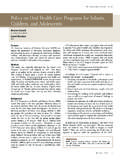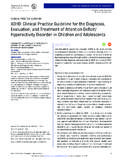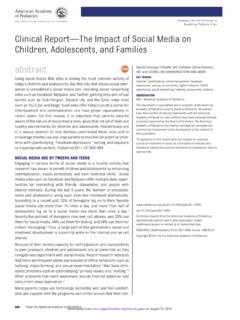Transcription of Guideline on Behavior Guidance for the Pediatric …
1 180 CLINICAL PRACTICE GUIDELINESREFERENCE MANUAL V 37 / NO 6 15 / 16 PurposeThe American Academy of Pediatric Dentistry (AAPD) rec-ognizes that dental care is medically necessary for the purpose of preventing and eliminating orofacial disease, infection, and pain, restoring the form and function of the dentition, and correcting facial disfiguration or Behavior Guidance techniques, both nonpharmalogical and pharma- logical, are used to alleviate anxiety, nurture a positive dental attitude, and perform quality oral health care safely and effi- ciently for infants, children, adolescents.
2 And persons with special health care needs. Selection of techniques must be tailored to the needs of the individual patient and the skills of the practitioner. The AAPD offers this Guideline to educate health care providers, parents, and other interested parties about influences on thebehavior of Pediatric dental patients and the many Behavior Guidance techniques used in contemporary Pediatric dentistry. Information regarding protective stabi-lization and pharmacological Behavior management for Pediatric dental patients is provided in greater detail in additional AAPD clinical practice document was developed subsequent to the AAPD s 1988 conference on Behavior management and modified following the AAPD s symposia on Behavior Guidance in 2003 and ,6 This update reflects a review of the most recent pro- ceedings.
3 Other dental and medical literature related to Behavior Guidance of the Pediatric patient, and sources of recognized professional expertise and stature including both the academic and practicing Pediatric dental communities and the stand- ards of the Commission on Dental In addition, a search of the PubMed electronic database was performed using the following parameters: Terms such as: Behavior management in children, Behavior management in dentistry, child Behavior and dentistry, child and dental anxiety, child preschool and dental anxiety, child personality and test, child preschool personality and test, patient cooperation, dentists and personality, dentist-patient relations, dentist-parent rela- tions, attitudes of parents to Behavior management in den- tistry, patient assessment in dentistry, pain in dentistry, treatment deferral in dentistry.
4 Toxic stress, cultural factors affecting Behavior in dentistry, culture of poverty, cultural factors affecting family compliance in dentistry, poverty and stress and effects on dental care, social risks and determinants of health in dentistry, gender shifts in dentistry, protective stabilization and dentistry, medical immobilization, restraint and dentistry, and patient restraint for treatment; Fields: all; Limits: within the last 10 years, humans, English, birth through age 18.
5 There were 5,843 articles matching these criteria. Papers for review were chosen from this list and from references within selected articles. When data did not appear sufficient or were inconclusive, recommendations were based upon expert and/or consensus opinion by experienced researchers and Dental practitioners are expected to recognize and effectively treat childhood dental diseases that are within the knowledge and skills acquired during their professional education.
6 Safe and effective treatment of these diseases requires an under- standing of and, at times, modifying the child s and family s response to care. Behavior Guidance is the process by which practitioners help patients identify appropriate and inappro-priate Behavior , learn problem solving strategies, and develop impulse control, empathy, and self-esteem. This process is a continuum of interaction involving the dentist and dental team, the patient, and the parent; its goals are to establish communication, alleviate fear and anxiety, deliver quality dental care, build a trusting relationship between dentist/staff and child/parent, and promote the child s positive attitude toward oral health care.
7 Knowledge of the scientific basis of Behavior Guidance and skills in communication, empathy, tolerance, cultural sensitivity, and flexibility are requisite to proper im- plementation. Behavior Guidance should never be punishment for misbehavior, power assertion, or use of any strategy that hurts, shames, or belittles a on Behavior Guidance for the Pediatric Dental Patient Originating Committee Clinical Affairs Committee Behavior Management SubcommitteeReview CouncilCouncil on Clinical AffairsAdopted 1990 Revised1991, 1996, 2000, 2005, 2006, 2008, 2011.
8 2015 AMERICAN ACADEMY OF Pediatric DENTISTRY CLINICAL PRACTICE guidelines 181 Predictors of child behaviorsPatient attributesA dentist who treats children should be able to accurately assess the child s developmental level, dental attitudes, and temperament and to anticipate the child s reaction to care. The response to the demands of oral health care is complex and determined by many factors. Developmental delay, physical/mental disability, and acute or chronic disease are potential reasons for noncompliance during the dental appointment.
9 In the healthy communicating child, behavioral influences often are more subtle and difficult to identify. Contributing factors can include fears, general or situational anxiety, a previous un-pleasant and/or painful dental/medical experience, inadequate preparation for the encounter, and parenting ,22-24 Only a minority of children with uncooperative Behavior have dental fears, and not all fearful children present dental be- havior Guidance ,11,12 Fears may occur when there is a perceived lack of control or potential for pain.
10 Especially when a child is aware of a dental problem or has had a painful health care experience. If the level of fear is incon- gruent with the circumstances and the patient is not able to control impulses, disruptive Behavior is likely. Cultural and linguistic factors also may play a role in atti- tudes and cooperation and Behavior Guidance of the Since every culture has its own beliefs, values, and practices, it is important to understand how to interact with patients from different cultures and to develop tools to help navigate their encounters.











